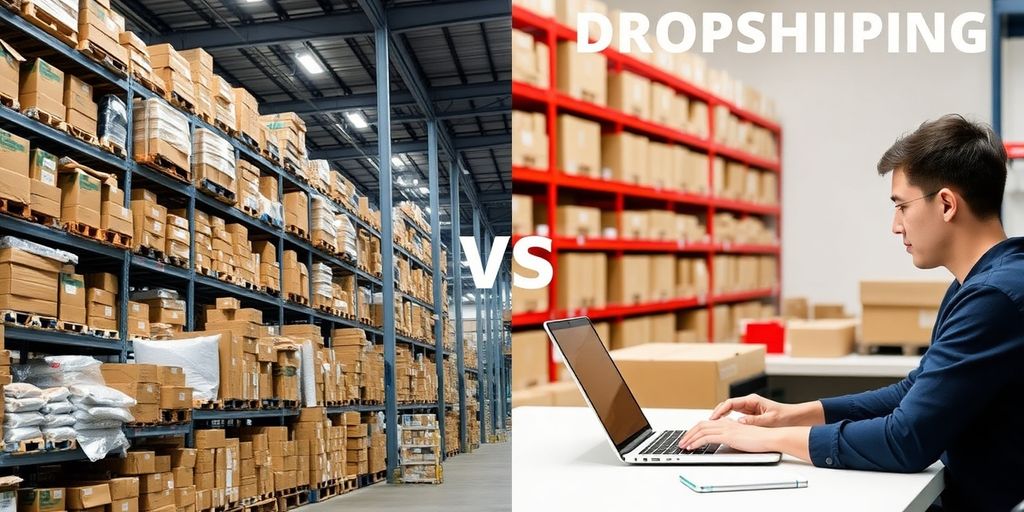
Dropship vs Inventory: A comparison between Dropshipping and all other eCommerce models
Share
In the world of online shopping, two popular business models stand out: dropshipping and inventory management. Each has its own unique characteristics, advantages, and challenges. This article explores the differences between dropshipping and traditional inventory systems, helping you decide which model might be the best fit for your eCommerce venture.
Dropshipping vs Inventory - Quick Facts and Key Differences Between the Two
| Feature | Dropshipping | Inventory Management |
|---|---|---|
| Initial Investment | Low | High |
| Control Over Stock | Limited | Full |
| Shipping Responsibility | Supplier handles it | Retailer handles it |
| Risk of Unsold Stock | Minimal | High |
| Profit Margins | Generally lower | Generally higher |
Quick Summary - dropshipping is all about flexibility and lower costs, while inventory management offers control and potentially higher profits. Each model has its own perks and challenges, so it’s essential for businesses to choose the one that fits their needs best.
Full Article: Understanding Dropshipping and Inventory Models
What is Dropshipping?
Dropshipping is a modern retail fulfillment method that lets e-commerce businesses sell products without keeping any inventory. Instead of stocking items, retailers take orders and pass them to suppliers, who then ship directly to customers. This means less risk and lower upfront costs for the retailer. It’s a great way to offer a wide range of products without the hassle of managing stock.
What is Inventory Management?
Inventory management is the traditional way of handling stock. Retailers buy products in bulk, store them, and ship them out as orders come in. This method gives retailers more control over their products and can lead to better customer service. However, it also requires a larger initial investment and ongoing management of stock levels.
Pros and Cons of Dropshipping
When it comes to dropshipping, there are definitely some highs and lows to consider. Let’s break it down:
Advantages of Dropshipping
- Low Risk: Since you don’t have to buy inventory upfront, the risk is much lower. You can start selling without worrying about unsold stock.
- Minimal Startup Capital Required: You can kick off your dropshipping business with very little money. No need to invest in a bunch of products right away!
- Easy to Manage: You don’t have to deal with packing, shipping, or storing products. Everything is handled by your suppliers.
- Global Reach: You can sell to customers all over the world without worrying about shipping logistics yourself.
Disadvantages of Dropshipping
- Low Profit Margins: Since you’re acting as a middleman, your profits can be pretty slim. You might find it hard to compete on price with others.
- Limited Quality Control: You don’t see the products before they reach your customers, which can lead to quality issues.
- Long Shipping Times: If your suppliers are overseas, shipping can take a while, which might frustrate your customers.
- Limited Control Over Delivery Timeline: You can’t control how fast your suppliers ship, which can lead to unhappy customers if things are delayed.
Is Dropshipping Right for You?
If you’re thinking about starting a dropshipping business, consider these points:
- Are you okay with lower profit margins?
- Can you handle potential quality issues?
- Are you prepared for long shipping times?
In summary, dropshipping can be a great way to start an online business with low costs, but it’s not without its challenges. So, is dropshipping the way to go? It depends on your business goals and how much risk you’re willing to take!
Pros and Cons of Holding Inventory
Benefits of Managing Your Own Stock
Holding inventory can be a game changer for many businesses. Here are some of the perks:
- Better Customer Service: When you have your own stock, you can respond to customer needs quickly. This means no waiting for suppliers to ship items, which can lead to happier customers.
- Bulk Discounts: Buying in larger quantities often means getting better prices from suppliers. This can help save money in the long run.
- Branded Experience: You can package your products just the way you want. This means you can create a unique unboxing experience for your customers, which can help build loyalty.
Challenges of Inventory Management
Of course, it’s not all sunshine and rainbows. Here are some challenges:
- You Need Space: Storing inventory requires physical space. Whether it’s a corner of your home or a rented warehouse, space can be a big issue.
- It Involves More Work: Managing inventory means keeping track of stock levels, ordering, and shipping. It can be a lot of work, especially if you’re just starting out.
- The Cash Outlay: You need to invest money upfront to buy inventory. This can be tough for new businesses that are still finding their feet.
Who Should Consider Holding Inventory?
Holding inventory might be the right choice for:
- Businesses with a steady demand for products.
- Entrepreneurs who want more control over their brand and customer experience.
- Companies that can afford the initial investment and have the space to store products.
In summary, while holding inventory can lead to improved customer service, it also comes with its own set of challenges. It’s essential to weigh these pros and cons carefully before making a decision!
Financial Implications: Dropship vs Inventory

When it comes to the financial side of things, the dropship vs inventory debate is pretty interesting. Let’s break it down:
Initial Investment Requirements
Starting with dropshipping, one of the biggest perks is that it requires a lower initial investment. You don’t need to buy a bunch of products upfront. Instead, you only pay for items after a customer orders them. This means less risk of being stuck with unsold stock. On the flip side, holding inventory means you need to spend money upfront to buy products, which can be a big hurdle for new businesses.
Profit Margins Explained
Now, let’s talk about profit margins. Generally, in-house inventory can lead to higher profit margins. Why? Because dropship suppliers often charge extra fees and have higher shipping costs. Here’s a quick comparison:
| Model | Profit Margin |
|---|---|
| Dropshipping | Lower (30-40%) |
| In-house Inventory | Higher (50-60%) |
So, if you’re looking to maximize profits, managing your own stock might be the way to go.
Cost Management Strategies
Managing costs is crucial in both models. Here are some strategies:
- Dropshipping:
- Inventory Management:
In conclusion, whether you choose dropshipping or holding inventory, each model has its own financial implications. It’s all about finding what works best for your business needs!
Operational Dynamics: How Each Model Works
Order Fulfillment Process
In the world of e-commerce, how you fulfill orders can make or break your business. Here’s a quick look at how dropshipping and inventory management differ:
- Dropshipping: When a customer places an order, the retailer sends the order details to a supplier. The supplier then ships the product directly to the customer. This means the retailer doesn’t handle the product at all.
- Inventory Management: Here, the retailer buys products in bulk, stores them, and ships them out as orders come in. This gives the retailer more control over the product but requires more upfront investment.
Shipping and Delivery Timelines
Shipping times can vary greatly between the two models:
| Model | Shipping Time | Control Over Delivery |
|---|---|---|
| Dropshipping | Often longer (depends on supplier) | Limited |
| Inventory | Usually faster (in-house) | High |
In dropshipping, the retailer relies on the supplier’s shipping speed, which can lead to delays. In contrast, inventory management allows for quicker shipping since the products are already on hand.
Handling Returns and Refunds
Returns can be a hassle, but how each model handles them is different:
- Dropshipping: Returns can be tricky since the retailer doesn’t have the product on hand. They often have to coordinate with the supplier, which can lead to longer processing times.
- Inventory Management: Retailers can handle returns directly, making the process smoother and faster for customers.
In summary, the operational dynamics of dropshipping and inventory management are quite different. Understanding these differences can help businesses choose the right model for their needs. Whether it’s the ease of dropshipping or the control of inventory management, each has its own set of advantages and challenges.
Customer Experience: Dropship vs Inventory

Impact on Customer Satisfaction
When it comes to customer satisfaction, the way a business handles orders can make a big difference. Dropshipping allows retailers to offer a wider variety of products, which can be a huge plus for customers. However, it can also lead to issues like delayed shipping or poor product quality if the supplier messes up. On the other hand, businesses that hold inventory can ship products faster and ensure quality, which often leads to happier customers.
Control Over Product Quality
With dropshipping, retailers rely on third-party suppliers to deliver products. This means they have less control over the quality of the items. If a customer receives a low-quality product, it reflects poorly on the retailer, even if it’s not their fault. In contrast, businesses that manage their own inventory can inspect products before shipping, ensuring that customers receive exactly what they expect.
Managing Customer Expectations
Managing what customers expect is crucial in eCommerce. Here are some key points to consider:
- Communication is Key: Keeping customers informed about their order status can help manage expectations, especially with dropshipping where delays can happen.
- Clear Return Policies: Having a straightforward return policy can ease customer worries, whether you’re dropshipping or holding inventory.
- Quality Assurance: Regularly checking the quality of products can help maintain a good reputation, especially for dropshippers who depend on suppliers.
In summary, while dropshipping offers a broader selection of products, it can come with risks that might affect customer satisfaction. On the flip side, holding inventory allows for better control over quality and faster shipping, which can lead to happier customers. Ultimately, the choice between dropshipping and inventory management will depend on what a business values more in terms of customer experience.
Scalability and Growth Potential

Expanding Your Product Range
When it comes to scaling a business, dropshipping offers a unique advantage. Since you don’t have to buy inventory upfront, you can quickly add new products to your store. This flexibility allows you to test different items without a huge financial commitment. However, it’s important to remember that your growth can be limited by your suppliers. If they can’t keep up with demand, your business might hit a wall.
Adapting to Market Changes
In the fast-paced world of eCommerce, being able to adapt is crucial. Dropshipping allows for quick changes in product offerings based on market trends. For example, if a new gadget becomes popular, a dropshipper can start selling it almost immediately. On the flip side, businesses that hold inventory might find it harder to pivot since they’re stuck with stock that may not sell.
Long-term Business Growth
While dropshipping can be a great way to start, it’s essential to think about long-term growth. Many successful eCommerce businesses eventually move towards holding inventory to improve profit margins and control over product quality. This shift can lead to better customer satisfaction and a stronger brand identity. In fact, eCommerce models can scale and grow bigger than dropshipping if done right, thanks to the ability to manage inventory and logistics more effectively.
| Model Type | Scalability Potential | Control Over Quality | Initial Investment |
|---|---|---|---|
| Dropshipping | High | Low | Low |
| Inventory | Moderate to High | High | High |
Branding and Customization Opportunities
Building a Unique Brand Identity
When it comes to branding, having a unique identity is key. For businesses that hold inventory, they can create custom packaging and branding elements that make their products stand out. This means they can design everything from the box to the labels, giving customers a memorable unboxing experience. In contrast, dropshipping often means products arrive in generic packaging, which can make it tough to build a strong brand presence.
Customization Options Available
Here are some ways businesses can customize their offerings:
- Custom Packaging: Create unique boxes or bags that reflect your brand.
- Personalized Inserts: Include thank-you notes or promotional materials in your shipments.
- Branded Labels: Use labels that showcase your logo and brand colors.
Balancing Brand and Supplier Relationships
While dropshipping allows for less upfront investment, it can limit branding opportunities. Businesses need to find a balance between working with suppliers and maintaining their brand identity. This can be tricky, but it’s essential for standing out in a crowded market. Branded dropshipping involves customizing products with branded packaging, labels, and other collateral, which can help in creating a more cohesive brand experience.
In summary, whether a business chooses dropshipping or inventory management, the approach to branding and customization can significantly impact their market presence and customer loyalty.
Choosing the Right Model for Your Business
When it comes to picking between dropshipping and holding inventory, it’s not just about what sounds cool; it’s about what fits your business best. Understanding your unique needs is key! Here are some things to think about:
Assessing Your Business Needs
- Startup Costs: If you’re just starting out, dropshipping can be a great way to keep costs low. You won’t need to buy a bunch of products upfront.
- Control: Do you want to have full control over your products? If yes, then holding inventory might be the way to go.
- Risk Tolerance: Are you okay with taking risks? Dropshipping has less financial risk since you don’t hold stock, but you might have lower profit margins.
Evaluating Market Competition
- Market Research: Look at what your competitors are doing. Are they using dropshipping or holding inventory? This can give you clues about what might work best.
- Customer Preferences: Think about what your customers want. Do they care about fast shipping and product quality? If so, having your own inventory might help.
- Niche Products: If you’re selling unique items, having inventory can help you stand out and build a strong brand.
Making the Final Decision
- Long-Term Goals: Consider where you want your business to be in a few years. Dropshipping is great for starting out, but if you want to grow and build a brand, holding inventory might be better.
- Flexibility: Think about how quickly you can adapt to changes in the market. Dropshipping can be more flexible, but managing your own stock can give you more control.
- Support Systems: Do you have a team to help with logistics? If not, dropshipping might save you a lot of headaches.
In the end, the choice between dropshipping and holding inventory depends on your specific situation. Take the time to weigh your options and choose the model that aligns with your business goals and lifestyle!
When it comes to picking the best model for your business, it's important to think about what fits your needs. Whether you're starting an online store or looking to invest, the right choice can make a big difference. Don't hesitate to explore our website for more tips and resources that can help you succeed!
Wrapping It Up: Dropshipping vs. Inventory
So, there you have it! When it comes to dropshipping versus holding inventory, both have their ups and downs. Dropshipping is like a low-risk way to start selling online without needing to buy a bunch of stuff upfront. You can offer tons of products without worrying about storage. But, you might face issues like lower profits and less control over shipping. On the flip side, having your own inventory means you can manage everything better and potentially make more money, but it also requires more cash and effort. Ultimately, the choice depends on what works best for you and your business goals. Whether you want to keep things simple with dropshipping or dive into the traditional inventory model, just make sure to weigh your options carefully!
Further Reading - Comparing Dropshipping to other eCommerce Models:
Shopify vs Amazon Dropshipping
Dropshipping Vs Print on Demand
Frequently Asked Questions
What is dropshipping?
Dropshipping is a way to sell products without keeping them in stock. When a customer orders something, you send that order to a supplier who ships it directly to the customer.
What are the main differences between dropshipping and holding inventory?
The key difference is that dropshipping doesn't require you to store products, while holding inventory means you buy and keep products yourself.
What are the advantages of dropshipping?
Some benefits of dropshipping include lower startup costs, a wider range of products to offer, and less stress about managing inventory.
What are the downsides of dropshipping?
Some challenges include lower profit margins, reliance on suppliers for shipping, and less control over product quality.
Is it better to hold inventory or dropship?
It depends on your business goals. Holding inventory can give you more control and higher profits, but requires more upfront investment.
How do profit margins compare between dropshipping and holding inventory?
Profit margins in dropshipping are usually lower because you pay suppliers for their products. With inventory, you can buy in bulk and set your own prices.
Can I combine dropshipping and inventory management?
Yes, many businesses use a mix of both. You can dropship some products while holding inventory for others to balance options and profits.
What should I consider when choosing between dropshipping and holding inventory?
Think about your budget, how much control you want over your products, and how quickly you need to fulfill orders.










































































































